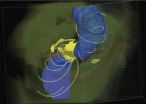(Press-News.org) Philadelphia, PA, February 21, 2013 – A new study published in the March issue of The American Journal of Pathology suggests that cortical type 2 cannabinoid (CB2) receptors might serve as potential therapeutic targets for cerebral ischemia.
Researchers found that the cannabinoid trans-caryophyllene (TC) protected brain cells from the effects of ischemia in both in vivo and in vitro animal models. In rats, post-ischemic treatment with TC decreased cerebral infarct size and edema. In cell cultures composed of rat cortical neurons and glia exposed to oxygen-glucose deprivation and reoxygenation (OGD/R), TC decreased neuronal injury and mitochondrial depolarization, specifically through type 2 cannabinoid receptor (CB2R) pathways.
"To our knowledge, novel data presented in this study provide evidence for the first time supporting a previously unappreciated role of cortical CB2R, especially neuronal CB2Rs, in ischemia," says lead investigator Won-Ki Kim, PhD, of the Department of Neuroscience, College of Medicine, Korea University in Seoul. "This study suggests that further investigation is warranted to establish the clinical usefulness of TC as a preventative and therapeutic agent for treatment of stroke."
Results presented in the study shed light on the anatomy and mechanism of action of CB2R-mediated neuroprotection. In the in vivo study, which was performed in rats, the right middle cerebral artery was occluded for 1.5 hours to mimic an ischemic stroke; blood flow was allowed to return for the next 24 hours. Three hours after the occlusion began, the animals were treated with TC; some animals also received AM630, a CB2R antagonist. The next day, the brains were removed, and the volume of the infarct and extent of cerebral edema were measured.
Using immunocytochemistry, the investigators found evidence of CB2Rs in the cortex of both control and ischemic brains, mostly in cortical neurons but also to a lesser extent in some glial cells. This finding in itself is important because the question of whether CB2Rs are present in the cortex has long been a matter of debate, say the authors.
Post-ischemic treatment with TC reduced infarct size by 53.8% and reduced edema by 51.9%. However, co-administration of the CB2R antagonist AM630 completely blocked the protective effect of TC. Further analysis indicated that CB2R activation is involved in the ability of TC to induce cAMP responsive element-binding protein (CREB) phosphorylation and increase the expression of brain-derived neurotrophic factor (BDNF) in ischemic tissue.
Cell-culture studies of embryonic rat cortical neurons and glia exposed to OGD/R to simulate ischemic insult confirmed some of the findings of the in vivo studies and contributed to further understanding about cellular effects of ischemia and TC treatment. In the cultures, TC decreased neuronal injury, intracellular oxidative stress, and mitochondrial depolarization following OGD/R, and the effects were reversed by AM630 but not by a CB1R antagonist, AM251. Western blot analysis demonstrated that TC enhanced the phosphorylation of AMP protein kinase (AMPK) and CREB, while selective AMPK and CREB inhibitors blocked TC's neuroprotection. Other findings indicated that the anti-ischemic effect of TC was not mediated by NMDA receptor antagonism or antioxidant activity.
TC is a major cannabinoid derived from the essential oil of the flowering plant Cannabis sativa, but has a fundamentally different structure from classical cannabinoids. Unlike agents which activate CB1 receptors, selective CB2R receptor agonists do not have psychoactive side effects. TC appears to maintain CB2R agonist activity when administered orally and is a common ingredient found in many food additives and folk medicines. The intriguing results of the present study suggest that the anti-ischemic benefits of TC deserve further exploration.
### END
Activation of cortical type 2 cannabinoid receptors ameliorates ischemic brain injury
Reported in The American Journal of Pathology
2013-02-21
ELSE PRESS RELEASES FROM THIS DATE:
Backs bear a heavy burden
2013-02-21
Trudging from place to place with heavy weights on our backs is an everyday reality, from schoolchildren toting textbooks in backpacks to firefighters and soldiers carrying occupational gear. Muscle and skeletal damage are very real concerns. Now Tel Aviv University researchers say that nerve damage, specifically to the nerves that travel through the neck and shoulders to animate our hands and fingers, is also a serious risk.
Prof. Amit Gefen of TAU's Department of Biomedical Engineering and Prof. Yoram Epstein of TAU's Sackler Faculty of Medicine, along with PhD student ...
Study reveals new clues to Epstein-Barr virus
2013-02-21
BOSTON -- Epstein-Barr virus (EBV) affects more than 90 percent of the population worldwide and was the first human virus found to be associated with cancer. Now, researchers from Beth Israel Deaconess Medical Center (BIDMC) have broadened the understanding of this widespread infection with their discovery of a second B-cell attachment receptor for EBV.
The new findings, which currently appear on-line in Cell Reports, reinforce current directions being taken in the development of a vaccine to guard against EBV, and raise important new questions regarding the virus's ...
UCLA study finds endocrine disorder is most common cause of elevated calcium levels
2013-02-21
Unusually high calcium levels in the blood can almost always be traced to primary hyperparathyroidism, an undertreated, underreported condition that affects mainly women and the elderly, according to a new study by UCLA researchers.
The condition, which results from overactive parathyroid glands and includes symptoms of bone loss, depression and fatigue that may go undetected for years, is most often seen in African American women over the age of 50, the researchers discovered.
The study, currently online in the Journal of Clinical Endocrinology and Metabolism, ...
Journey to the limits of spacetime
2013-02-21
Voracious absences at the center of galaxies, black holes shape the growth and death of the stars around them through their powerful gravitational pull and explosive ejections of energy.
"Over its lifetime, a black hole can release more energy than all the stars in a galaxy combined," said Roger Blandford, director of the Kavli Institute for Particle Astrophysics and Cosmology and a member of the U.S. National Academy of Science. "Black holes have a major impact on the formation of galaxies and the environmental growth and evolution of those galaxies."
Gravitational ...
Baylor University researchers study barriers, resources to physical activity in Texas towns
2013-02-21
WACO, Texas (Feb. 20, 2013) —Obesity, diabetes and other ailments plague impoverished communities at higher rates than the general United States population. In rural Texas border towns, or colonias, Mexican-American residents are at an even greater risk for chronic health problems.
Physical activity has shown to reduce the risks for chronic health problems, but "few Mexican-American and lower-income Americans, including children, engage in physical activity that bring about health benefits," according to a study conducted by Baylor University and Texas A&M University ...
How human language could have evolved from birdsong
2013-02-21
CAMBRIDGE, MA -- "The sounds uttered by birds offer in several respects the nearest analogy to language," Charles Darwin wrote in "The Descent of Man" (1871), while contemplating how humans learned to speak. Language, he speculated, might have had its origins in singing, which "might have given rise to words expressive of various complex emotions."
Now researchers from MIT, along with a scholar from the University of Tokyo, say that Darwin was on the right path. The balance of evidence, they believe, suggests that human language is a grafting of two communication forms ...
Facing disaster while averting tragedy
2013-02-21
This press release is available in French.
Montreal, February 21, 2013 – Nobody can foresee disaster, but changing climate conditions are prompting smart communities increasingly to prepare for them with solid emergency response plans and protocols. Images as recent as those from the 2011 wildfire in Slave Lake, Alberta or as distant as those from the 1998 ice storm in Eastern Ontario and Quebec are distressing reminders that no area is immune from devastation, and reinforce the need to be prepared.
Yet while emergency responses may originate through official channels, ...
Antioxidants in your diet may not reduce risk of stroke or dementia
2013-02-21
MINNEAPOLIS – Contrary to other research, a new study found that the total level of antioxidants in people's diets is not related to their risk of developing stroke or dementia. The study is published in the February 20, 2013, online issue of Neurology®, the medical journal of the American Academy of Neurology. Antioxidants such as lycopene, beta-carotene and vitamins C and E are found in many foods.
"These results are interesting because other studies have suggested that antioxidants may help protect against stroke and dementia," said study author Elizabeth E. Devore, ...
New research on migratory behavior of oceanic whitetip sharks can help shape conservation strategies
2013-02-21
STONY BROOK, NY, February 20, 2013–As the nations of the world prepare to vote on measures to restrict international trade in endangered sharks in early March, a team of researchers has found that one of these species – the oceanic whitetip shark – regularly crosses international boundaries. Efforts by individual nations to protect this declining apex predator within their own maritime borders may therefore need to be nested within broader international conservation measures.
The research team, which included researchers from Microwave Telemetry, Inc., the Cape Eleuthera ...
Study advances LSUHSC research, shows fish oil component reduces brain damage in newborns
2013-02-21
New Orleans, LA – Research conducted by a team of scientists from Columbia University College of Physicians and Surgeons and Dr. Nicolas Bazan, Boyd Professor and Director of the Neuroscience Center of Excellence at LSU Health Sciences Center New Orleans, found the novel use of a component of fish oil reduced brain trauma in newborn mice. The study reports that neonatal brain damage decreased by about 50% when a triglyceride lipid emulsion containing docosahexaenoic acid (DHA) was injected within two hours of the onset of ischemic stroke. The paper, n-3 Fatty Acid Rich ...
LAST 30 PRESS RELEASES:
Young adults commonly mix cannabis with nicotine and tobacco
Comprehensive review illuminates tau protein's dual nature in brain health, disease, and emerging psychiatric connections
Book prepares K-12 leaders for the next public health crisis
Storms in the Southern Ocean mitigates global warming
Seals on the move: Research reveals key data for offshore development and international ecology
Sports injuries sustained during your period might be more severe
World's first successful 2 Tbit/s free-space optical communication using small optical terminals mountable on satellites and HAPS
Can intimate relationships affect your heart? New study says ‘yes’
Scalable and healable gradient textiles for multi‑scenario radiative cooling via bicomponent blow spinning
Research shows informed traders never let a good climate crisis go to waste
Intelligent XGBoost framework enhances asphalt pavement skid resistance assessment
Dual-function biomaterials for postoperative osteosarcoma: Tumor suppression and bone regeneration
New framework reveals where transport emissions concentrate in Singapore
NTP-enhanced lattice oxygen activation in Ce-Co catalysts for low-temperature soot combustion
Synergistic interface engineering in Cu-Zn-Ce catalysts for efficient CO2 hydrogenation to methanol
COVID-19 leaves a lasting mark on the human brain
Scientists use ultrasound to soften and treat cancer tumors without damaging healthy tissue
Community swimming program for Black youth boosts skills, sense of belonging, study finds
Specific depressive symptoms in midlife linked to increased dementia risk
An ‘illuminating’ design sheds light on cholesterol
Who is more likely to get long COVID?
Study showcases resilience and rapid growth of “living rocks”
Naval Research Lab diver earns Office of Naval Research 2025 Sailor of the Year
New Mayo-led study establishes practical definition for rapidly progressive dementia
Fossil fuel industry’s “climate false solutions” reinforce its power and aggravate environmental injustice
Researchers reveal bias in a widely used measure of algorithm performance
Alcohol causes cancer. A study from IOCB Prague confirms damage to DNA and shows how cells defend against it
Hidden viruses in wastewater treatment may shape public health risks, study finds
Unlock the power of nature: how biomass can transform climate mitigation
Biochar reshapes hidden soil microbes that capture carbon dioxide in farmland
[Press-News.org] Activation of cortical type 2 cannabinoid receptors ameliorates ischemic brain injuryReported in The American Journal of Pathology

